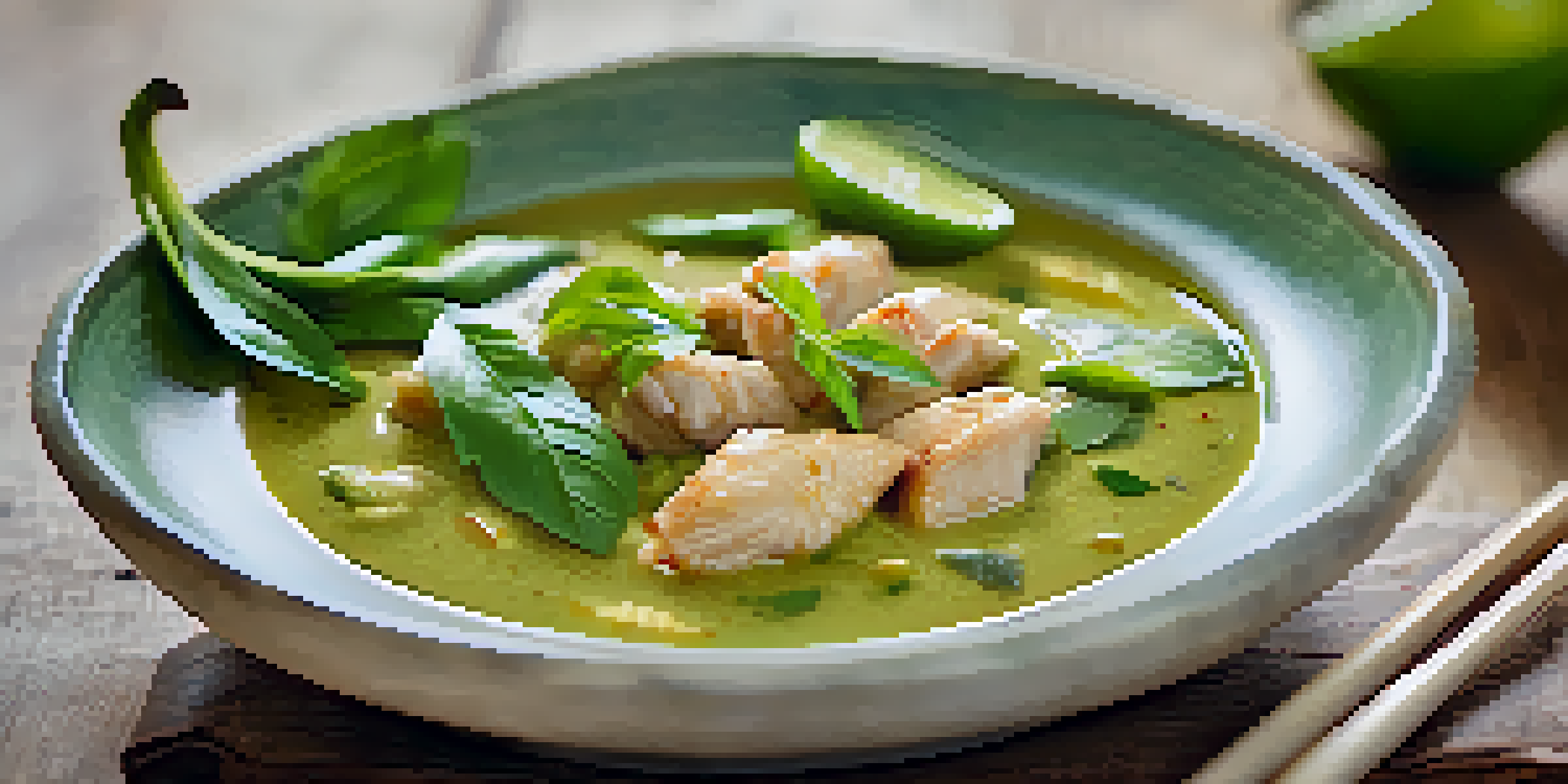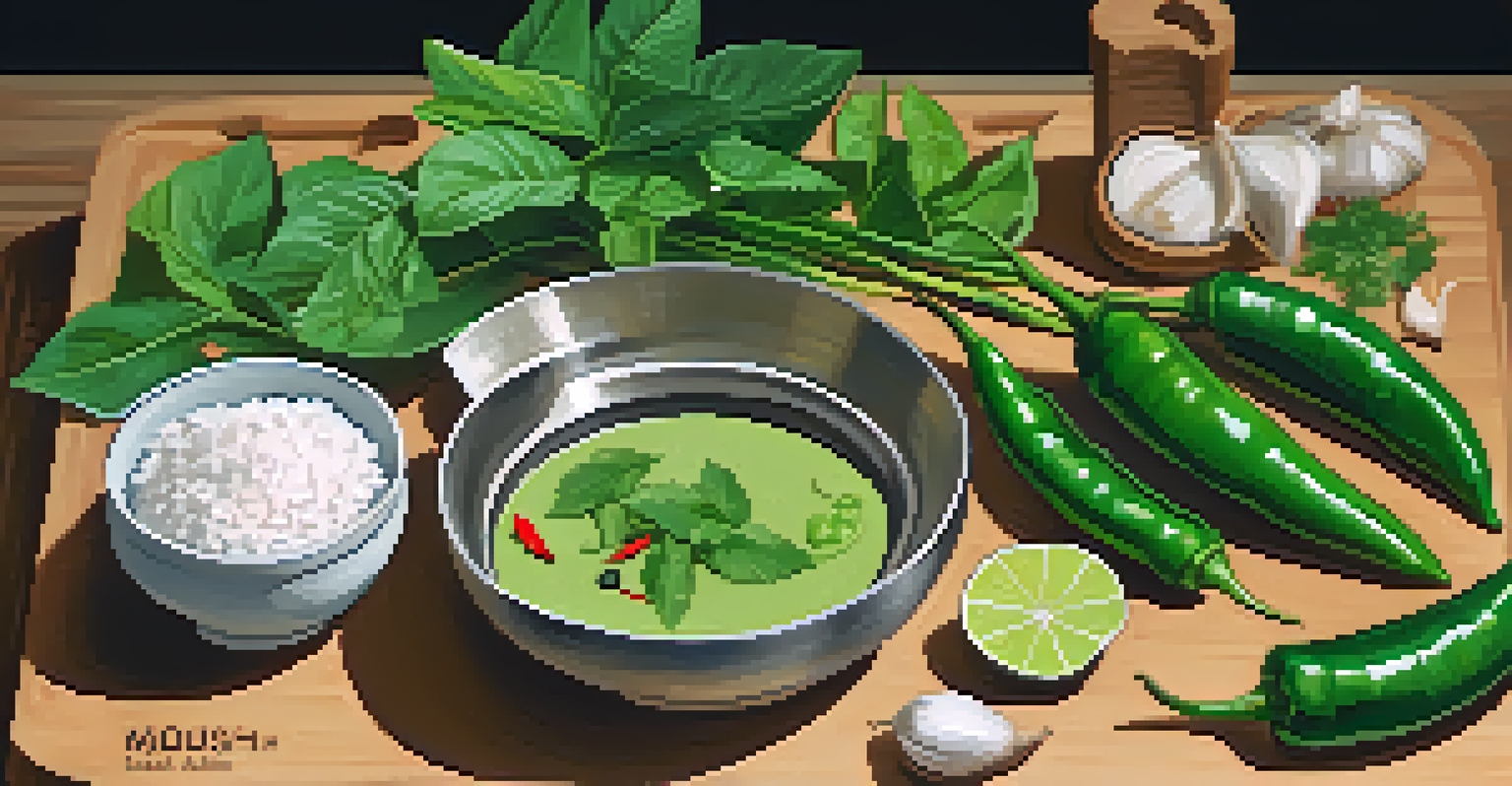Green Curry: Exploring Its Roots and Cultural Significance

The Origins of Green Curry: A Culinary History
Green curry, known as 'Gaeng Khiao Wan' in Thai, traces its roots back to the central region of Thailand. This dish has evolved over centuries, influenced by various cultures, including Chinese and Indian cuisines. The vibrant green color comes from fresh green herbs and chilies, making it a feast for the eyes and the palate.
Food is not just eating energy. It's an experience.
Traditionally, green curry was prepared with a mortar and pestle, allowing chefs to create a rich paste combining ingredients like cilantro, basil, and green chilies. This method not only enhances flavors but also connects the cook to the dish's heritage. The popularity of green curry has spread beyond Thailand, becoming a staple in Thai restaurants worldwide.
As we explore its history, it's clear that green curry reflects Thailand's agricultural abundance. The use of fresh, local ingredients showcases the region's biodiversity and the importance of seasonal cooking, making it much more than just a meal—it's a cultural expression.
Key Ingredients: What Makes Green Curry Unique
The essence of green curry lies in its distinctive ingredients, which create a harmonious blend of flavors. Key components include green chilies, coconut milk, and a variety of herbs such as basil and cilantro. Each ingredient plays a crucial role, contributing to the dish's vibrant color and complex taste.

Green chilies provide the signature heat, while coconut milk adds creaminess, balancing the spice perfectly. The fresh herbs not only enhance the flavor but also bring freshness, making every bite a delight. Additionally, proteins like chicken, beef, or tofu are often added, allowing for versatility in preparation.
Cultural Roots of Green Curry
Green curry, or 'Gaeng Khiao Wan,' reflects Thailand's agricultural abundance and cultural heritage through its rich history and traditional preparation methods.
This combination of spices and ingredients is not just about taste; it tells a story of the land and its produce. Each element is a reflection of Thailand's culture, showcasing the importance of fresh, local ingredients in Thai cuisine.
Cultural Significance: Green Curry in Thai Society
In Thai culture, food is more than sustenance; it is a way to connect with family and community. Green curry is often served during special occasions and gatherings, symbolizing hospitality and warmth. Sharing a meal featuring green curry can strengthen bonds and create lasting memories.
Cooking is like love. It should be entered into with abandon or not at all.
Moreover, the preparation of green curry can be a communal activity, where families come together to create the dish from scratch. This practice fosters teamwork and allows for the passing down of culinary traditions from one generation to the next. It's a beautiful way to honor heritage while enjoying delicious food.
Beyond its role in family gatherings, green curry is also celebrated in festivals and cultural events, showcasing the vibrancy of Thai cuisine to the world. This dish serves as a culinary ambassador, introducing people to the rich flavors and traditions of Thailand.
Preparing Green Curry: A Step-by-Step Guide
Making green curry at home might seem daunting, but it can be a rewarding experience. Start by gathering your ingredients: fresh green chilies, coconut milk, garlic, and your choice of protein. The first step is to make the green curry paste, which can be done by blending the herbs and spices until smooth.
Once you have your paste ready, heat some oil in a pan and sauté the paste until fragrant. Add coconut milk and your protein to the mix, allowing it to simmer until cooked through. Finally, toss in some fresh basil for that aromatic finish, and your green curry is ready to be served over rice!
Key Ingredients Define Flavor
The unique combination of green chilies, coconut milk, and fresh herbs creates the vibrant flavor profile that sets green curry apart in Thai cuisine.
This hands-on approach not only makes for a delicious meal but also connects you to the tradition of cooking in Thailand. You can customize the spice level and ingredients to suit your taste, making it a personal and enjoyable culinary adventure.
Variations of Green Curry: Regional Twists and Adaptations
While the classic Thai green curry is beloved worldwide, various regions have put their own spin on this dish. For example, in some parts of Thailand, you might find green curry made with eggplant, while others incorporate vegetables like zucchini or bell peppers. These adaptations reflect local tastes and ingredient availability.
In addition to regional variations, chefs around the globe have embraced green curry, infusing it with their own culinary influences. You'll see green curry used in fusion dishes, such as green curry pasta or pizza, which offer a fun twist on traditional flavors. This evolution showcases the versatility of green curry and its ability to adapt.
These variations highlight a key aspect of cuisine: it is always evolving. Whether you stick to the classic recipe or experiment with new ingredients, green curry remains a celebration of flavor and creativity.
Health Benefits of Green Curry: Nutritional Insights
Beyond its mouthwatering taste, green curry also packs a nutritional punch. The fresh herbs and spices used in green curry are loaded with vitamins and antioxidants. For instance, basil is known for its anti-inflammatory properties, while green chilies can boost metabolism and add a kick of flavor.
Coconut milk, a key ingredient, provides healthy fats that can be beneficial for heart health when consumed in moderation. Additionally, the inclusion of vegetables in the curry offers essential nutrients and fiber, making it a wholesome meal option. It's a great way to sneak in more greens into your diet!
Global Popularity and Adaptations
Green curry's worldwide appeal has led to various regional adaptations and fusion dishes, showcasing its versatility and ability to connect diverse culinary traditions.
Enjoying green curry can be a delightful way to nourish your body while indulging in delicious flavors. It exemplifies how traditional dishes can be both satisfying and health-conscious, allowing you to enjoy every bite guilt-free.
The Global Appeal of Green Curry: A Culinary Icon
Green curry has transcended borders, becoming a beloved dish in various countries. Its popularity can be attributed to its unique flavor profile and the vibrant presentation that draws food lovers in. As people become more adventurous in their culinary choices, green curry stands out as a must-try dish.
In many cities around the world, Thai restaurants prominently feature green curry on their menus, often becoming a signature dish. This global acceptance speaks to the universal love for diverse flavors and the desire to experience different cultures through food. It's an exciting way to explore other traditions without leaving your hometown.

As green curry continues to gain traction internationally, it serves as a reminder of the power of food to unite people. Whether enjoyed in a local eatery or prepared at home, green curry invites everyone to share in the joy of culinary exploration and cultural appreciation.